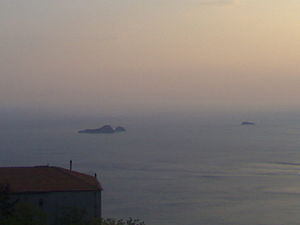Li Galli
| Li Galli | ||
|---|---|---|
| Li Galli of Positano seen from | ||
| Waters | Tyrrhenian Sea , ( Gulf of Salerno ) | |
| Geographical location | 40 ° 35 ' N , 14 ° 26' E | |
|
|
||
| Number of islands | 3 | |
| Main island | Gallo Lungo | |
| Total land area | 0.08 km² | |
| Residents | uninhabited | |
Li Galli (Italian for 'the cocks', also Sirenusen ) is the name of a group of islands in the Tyrrhenian Sea off the Amalfi Coast . It consists of three small islands and belongs to the territory of the Italian municipality of Positano .
geography
The islands are located in the Gulf of Salerno , south of the Sorrento peninsula . These are the islands:
- Gallo Lungo ('long cock', 40 ° 34 ′ 57 ″ N , 14 ° 26 ′ 9 ″ E )
- La Rotonda ('the round', 40 ° 34 ′ 47 ″ N , 14 ° 25 ′ 55 ″ E )
- Dei Briganti a nord della Rotonda ('island of the brigands north of the rounds', also Castelluccio or La Castelluccia , 40 ° 34 ′ 51 ″ N , 14 ° 25 ′ 55 ″ E )
history
The Greek geographer Strabon (63-19 BC), who was the first to describe the three islands, identified them with the islands of the mythical sirens , often described in three numbers, and gave them the name Sirenuses ( Greek Σειρηνοῦσσαι Seirēnoussai ). Like the mythical sirens, the real rock islands posed a serious threat to coastal seafaring in ancient times. The modern name is also said to refer to the iconography of the sirens, who were depicted as half human, half bird. In 1225 the Staufer Emperor Friedrich II gave the islands to the monastery of Positano. Here they were mentioned as tres Sirenas quae dicitur Gallus ('three sirens who are called cock').
The largest of the islands, Gallo Lungo, is the only one that has been inhabited since ancient times, it is around 400 meters long and up to 200 meters wide. In 1924 the Russian choreographer and dancer Léonide Massine acquired the archipelago and had a large villa built on Gallo lungo, which Le Corbusier converted thirteen years later . In 1989 she bought Rudolf Nureyev ; After his death in 1993, an Italian tourism company acquired the islands and has been offering them for rent ever since.
Others
The archipelago is part of the Punta Campanella nature reserve .
Web links
- Website of the municipality of Positano (ital.)
- Photo of the islands
- Portrait with photos on insulae.it (ital.)


